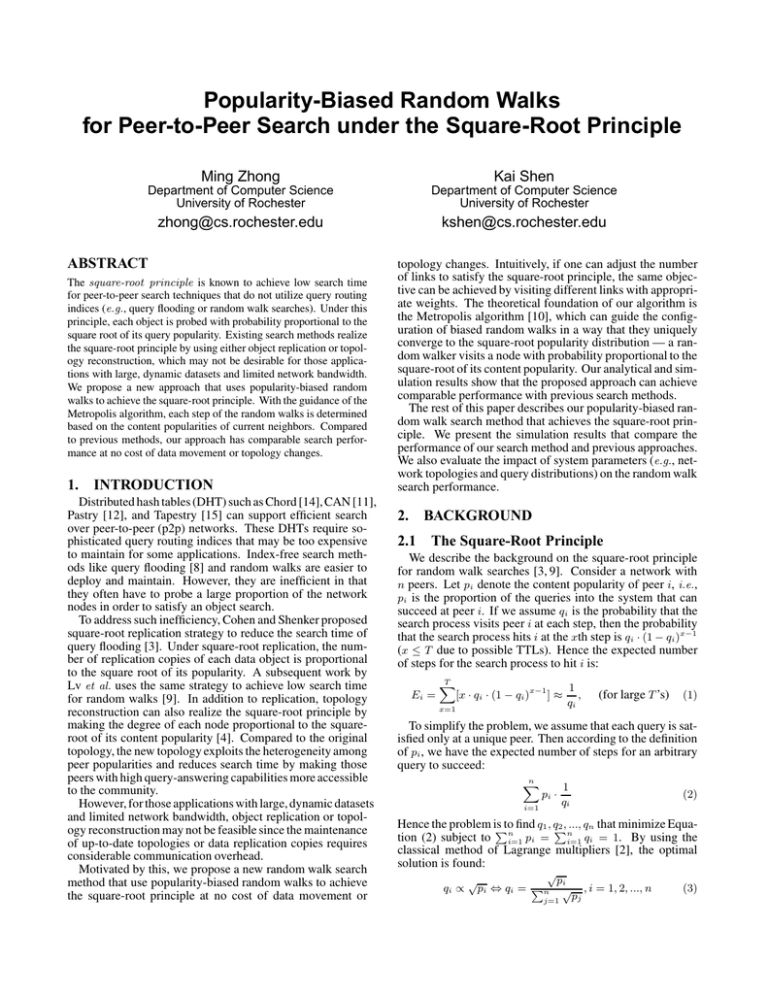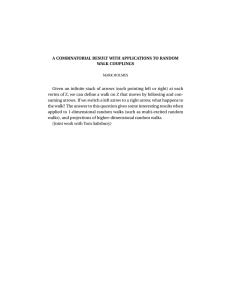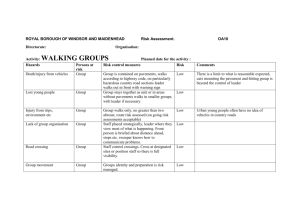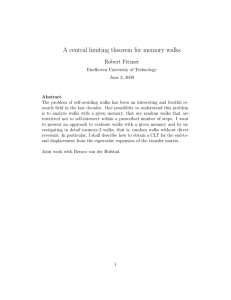Popularity-Biased Random Walks for Peer-to-Peer Search under the Square-Root Principle Ming Zhong
advertisement

Popularity-Biased Random Walks
for Peer-to-Peer Search under the Square-Root Principle
Ming Zhong
Kai Shen
Department of Computer Science
University of Rochester
Department of Computer Science
University of Rochester
zhong@cs.rochester.edu
kshen@cs.rochester.edu
ABSTRACT
The square-root principle is known to achieve low search time
for peer-to-peer search techniques that do not utilize query routing
indices (e.g., query flooding or random walk searches). Under this
principle, each object is probed with probability proportional to the
square root of its query popularity. Existing search methods realize
the square-root principle by using either object replication or topology reconstruction, which may not be desirable for those applications with large, dynamic datasets and limited network bandwidth.
We propose a new approach that uses popularity-biased random
walks to achieve the square-root principle. With the guidance of the
Metropolis algorithm, each step of the random walks is determined
based on the content popularities of current neighbors. Compared
to previous methods, our approach has comparable search performance at no cost of data movement or topology changes.
1.
INTRODUCTION
Distributed hash tables (DHT) such as Chord [14], CAN [11],
Pastry [12], and Tapestry [15] can support efficient search
over peer-to-peer (p2p) networks. These DHTs require sophisticated query routing indices that may be too expensive
to maintain for some applications. Index-free search methods like query flooding [8] and random walks are easier to
deploy and maintain. However, they are inefficient in that
they often have to probe a large proportion of the network
nodes in order to satisfy an object search.
To address such inefficiency, Cohen and Shenker proposed
square-root replication strategy to reduce the search time of
query flooding [3]. Under square-root replication, the number of replication copies of each data object is proportional
to the square root of its popularity. A subsequent work by
Lv et al. uses the same strategy to achieve low search time
for random walks [9]. In addition to replication, topology
reconstruction can also realize the square-root principle by
making the degree of each node proportional to the squareroot of its content popularity [4]. Compared to the original
topology, the new topology exploits the heterogeneity among
peer popularities and reduces search time by making those
peers with high query-answering capabilities more accessible
to the community.
However, for those applications with large, dynamic datasets
and limited network bandwidth, object replication or topology reconstruction may not be feasible since the maintenance
of up-to-date topologies or data replication copies requires
considerable communication overhead.
Motivated by this, we propose a new random walk search
method that use popularity-biased random walks to achieve
the square-root principle at no cost of data movement or
topology changes. Intuitively, if one can adjust the number
of links to satisfy the square-root principle, the same objective can be achieved by visiting different links with appropriate weights. The theoretical foundation of our algorithm is
the Metropolis algorithm [10], which can guide the configuration of biased random walks in a way that they uniquely
converge to the square-root popularity distribution — a random walker visits a node with probability proportional to the
square-root of its content popularity. Our analytical and simulation results show that the proposed approach can achieve
comparable performance with previous search methods.
The rest of this paper describes our popularity-biased random walk search method that achieves the square-root principle. We present the simulation results that compare the
performance of our search method and previous approaches.
We also evaluate the impact of system parameters (e.g., network topologies and query distributions) on the random walk
search performance.
2. BACKGROUND
2.1 The Square-Root Principle
We describe the background on the square-root principle
for random walk searches [3, 9]. Consider a network with
n peers. Let pi denote the content popularity of peer i, i.e.,
pi is the proportion of the queries into the system that can
succeed at peer i. If we assume qi is the probability that the
search process visits peer i at each step, then the probability
that the search process hits i at the xth step is qi · (1 − qi )x−1
(x ≤ T due to possible TTLs). Hence the expected number
of steps for the search process to hit i is:
Ei =
T
X
x=1
[x · qi · (1 − qi )x−1 ] ≈
1
,
qi
(for large T ’s)
(1)
To simplify the problem, we assume that each query is satisfied only at a unique peer. Then according to the definition
of pi , we have the expected number of steps for an arbitrary
query to succeed:
n
X
i=1
pi ·
1
qi
(2)
Hence the problem isPto find q1 , qP
2 , ..., qn that minimize Equation (2) subject to ni=1 pi = ni=1 qi = 1. By using the
classical method of Lagrange multipliers [2], the optimal
solution is found:
qi ∝
√
pi
√
pi ⇔ qi = Pn √ , i = 1, 2, ..., n
pj
j=1
(3)
For the above optimal solution of q , the expected number of
steps for an arbitrary query to succeed after the convergence
of random walks is:
n
X
1
pi ·
=
q
i
i=1
n
X
√
pi
i=1
!2
(4)
Specifically, for Zipf-like popularity distributions with pi ∝
( 1i )α , α > 0, 1 ≤ i ≤ n, the expected search time for the
square-root principle is:
8
1−α
n · (1−
>
α )2 = Θ(n)
>
2
>
>
n
>
4
·
= Θ( logn n )
!2 >
log n
>
n
<
2−α
X
n
√
= Θ(n2−α )
pi
≈
C(α)·(1− α
)2
2
>
2
> log n = Θ(log 2 n)
i=1
>
>
C(α)
>
>
>
: C( α2 )2 = Θ(1)
C(α)
if 0 < α < 1;
if α = 1;
if 1 < α < 2;
if α = 2;
if α > 2 .
(5)
where C(α) (α > 1) is the
summation constant for
P power
1 α
large n’s, i.e., C(α) ≈ ∞
(
)
.
For example, C(2) ≈
i=1 i
1.6449, C(3) ≈ 1.2021.
2.2 Biased Random Walks and the Metropolis
Algorithm
Let G = (V, E) be an undirected connected graph. A
random walk on G starts at node v0 , which is either fixed
or drawn from some initial distribution π0 . If the random
walk is at node vt at time step t, then it moves to a neighbor
vt+1 of node vt at step t + 1, chosen randomly with certain
probability distribution.
Let πt denote the distribution of node vt so that πt (i) =
P rob(vt = i), i ∈ V . Let P = (Pi,j ), i, j ∈ V , denote the
transition matrix of the random walk—Pi,j is the probability
that the random walk moves from node i to node j in one
step. Pi,j = 0 if nodes i, j are not adjacent. The dynamics
of the random walk follows πt+1 = πt P = π0 P t+1 .
The following theorem by Doeblin [5] gives sufficient conditions for the unique convergence of random walks.
Theorem 1. [5] If P is irreducible and aperiodic, then
πt converges to a unique stationary distribution π such that
πP = π independent of the initial distribution π0 .
Here P is irreducible if and only if for any i, j , there exists
a t such that (P t )i,j > 0. P is aperiodic if and only if for any
i, j the greatest common divisor of the set {t : (P t )i,j > 0} is
1. Intuitively irreducibility means that any two nodes are mutually reachable by random walks. Aperiodicity means that
the graph G is non-bipartite. Aperiodicity can be achieved by
introducing self-loop transitions of some positive probability
on each node of the graph.
Given the guarantee on the unique convergence of selfloop enabled random walks on undirected connected graphs,
the next question is this: How to define the transition matrix P such that the random walk converges to the desired
probability distribution? The Metropolis algorithm [1, 10]
was designed as a standard approach to assign transition
probabilities to Markov chains so that they converge to any
specified probability distributions.
Theorem 2. [1, 10] Let G = (V, E) be an undirected
connected graph, and let π be the desired probability distribution. Let di denote the degree of node i. For each neighbor
j of node i, let
Pi,j =
(
1
2
1
2
·
·
1
di
1
dj
if
·
π(j)
π(i)
if
π(i)
di
π(i)
di
≤
>
π(j)
;
dj
π(j)
.
dj
P
and Pi,i = 1 − j∈ neighbors(i) Pi,j . Then π is the unique
converged stationary probability distribution of the random
walk with transition matrix P .
It is easy to prove that π is a converged distribution of
the above random walk by verifying πP = π . As explained
before, the laziness factor 12 , which could be any constant
between 0 and 1, ensures that each node has a self-loop and
hence the above random walk also uniquely converges to π .
Note that the Metropolis algorithm only requires the ratio
π(j)
without the need for knowing each individual π(i) or the
π(i)
P
normalization factor i π(i).
Our previous work has employed biased random walks to
support non-uniform random membership management in
peer-to-peer networks [16].
3. BIASED RANDOM WALKS TO REALIZE THE SQUARE-ROOT PRINCIPLE
We propose a new random walk search method that realizes
the square-root principle as achieved by object replication [3,
9] and topology reconstruction [4], but without the overhead
of adjusting replication copies or network topologies upon
dataset changes. Under our method, each query issues a
popularity-biased random walker, which travels around the
network until the requested object is discovered or the TTL
has expired. At each step of the walk, the next hop is chosen
from the neighbors of the current node with probabilities
biased towards their content popularities.
The Metropolis algorithm [10] can help us configure the
bias probabilities at each random walk step such that the random walk converges to the desired node visitation probability distribution. Specifically, we determine our probabilitybiased random walk as follows.
Let pi , the peer content popularity, be defined the same
as in Section 2.1. Let di denote the number of network
neighbors for peer i. If a random walker is at peer i at a
certain time step, then for each neighbor j of i it moves to j
with probability Pi,j after next step, where:
Pi,j =
(
1
2
1
2
·
·
1
di
1
dj
·
√
pj
√
pi
if
if
√
pi
di
√
pi
di
≤
>
√
pj
dj
√
pj
dj
;
.
(6)
and the probability
P for the random walk does not move at the
step Pi,i = 1 − k∈ neighbor(i) Pi,k . The peer content popularity pi can be estimated as the number of queries satisfied
at peer i divided by the total number of queries received by
i [4]. Hence Pi,j is locally computable (it only requires the
local information of peer i and its adjacent nodes).
The node visitation distribution of the random walks will
converge with the increasing number of random walk steps.
Let π denote the converged distribution of our random walks
(i.e., a random walker visits peer i with probability π(i) at
any step after the convergence). Then π must satisfy:
π(i) ∝
√
pi
√
P
pi ⇔ π(i) =
√
n
pj
j=1
(7)
This can be easily proved by verifying π · P = π . Moreover,
The laziness factor 21 in Equation (6) ensures that each peer
has a self-loop and hence the converged distribution is unique
(Theorem 1).
According to Equation (3), the converged distribution of
our popularity-biased random walks satisfies the square-root
principle and hence minimizes the search time. We expect
random walks to converge fast on typical p2p network topologies with good expansion properties (e.g., random graphs and
random power-law graphs). We will provide quantitative
measurement results in Section 4.
Current random walk search methods [9] typically use
multiple independent random walkers with the expectation
that k independent random walkers after T steps should cover
nearly equal number of nodes as one random walker after
k · T steps. Hence the search time can be reduced by roughly
k times with no extra communication overhead. We will
also use multiple independent random walks as defined in
Equation (6) and examine their performance variations in
our simulation.
4.
SIMULATION
We compare the performance of the three different search
methods that realize the square-root principle: our popularitybiased random walks, object replication, and topology reconstruction. Although object replication and topology reconstruction can be used to support both query flooding searches
and random walk searches, our simulation study focuses on
the performance of the three methods supporting random
walk searches.
It is important to keep in mind that object replication and
topology reconstruction must maintain up-to-date replication
copies and network topologies to achieve the search performance presented in this section. Our popularity-biased
random walks do not incur such costs. These costs can be
very substantial in large networks with dynamic searchable
datasets.
In addition to the performance comparison, another objective of the simulation is to evaluate the impact of system
parameters (e.g., network topologies and query distributions)
on the random walk search performance.
4.1 Simulation Setup
The three search methods are set up as follows.
1. Square-root replication. Each object is replicated randomly over the network in a way that the number of
replication copies is proportional to the square-root of
its popularity. One uniform random walker is used
for searching the network while we set the average
number of replication copies as the number of random
walkers used in square-root topology and square-root biased walks. This is intended to make a fair comparison
since the expected search time for square-root replication is inversely proportional to the average number of
replication copies.
2. Square-root topology. Uniform random walkers are
used to search the network. The degree of each node
is proportional to the square root of its content popularity. To transform the original topology into this
square-root topology, we compute the node degree sequence and use the PLRG algorithm [7] to generate the
new randomized topology with the desired node degree
sequence.
System parameters
Network size
Number of objects
Number of queries
Average per-link latency
Value
20,000
1,000,000
100,000
50 ms
Table 1: Default simulation parameters.
3. Square-root biased walks. Without adjusting topologies or replicating data, each query issues a number
of random walkers that travel the network according
to Equation (6). Multiple random walkers coordinate
with each other by periodically calling back the source
to learn whether any other walker has found the target.
If so, the remaining walkers will terminate upon next
call.
In our simulation, the query popularity follows Zipf-like
distribution (the frequency of the ith most popular query is
proportional to i1α ). Specifically, we choose α = 0.6 and
α = 1.2 based on Sripanidkulchai’s measurement results on
Gnutella traces [13].
We use random graphs and random power-law graphs as
network topologies in our simulation. Random graphs represent those p2p topologies where new links are made independent of existing node degrees. Random power-law graphs
represent those networks where new links are more likely attached to nodes with large degrees. In our simulation, the
random power-law graphs are generated by using the PLRG
algorithm [7]. We use the random power-law graphs with
α = 0.8, following Lv et al.’s simulation setup [9]. We generate random graphs by connecting each new nodes to some
nodes selected uniformly at random from all existing nodes.
Some default simulation parameters are listed in Table 1.
4.2 Simulation Results
Figures 1 and 2 present the search time and communication
overhead on different network topologies (random graphs
and random power-law graphs), query popularity distributions, and a variety of settings on the random walker count
(k). We observe that the three random walk search methods
have similar performance with small variations (average 14%
difference for random graphs and 19% for random powerlaw
graphs). The performance difference is mainly due to the
different speeds at which the three methods converge to the
targeted square-root object probe distribution.
We perform measurements to specifically measure the
random walk convergence speeds. Figures 3 and 4 show
that the square-root replication has better convergence speed
than the square-root biased walks which in turn has better convergence speed than the square-root topology. Due
to its non-uniformity, our popularity-biased random walks
has slower convergence and hence lower search performance
than square-root replication. The square-root topology has
the slowest convergence speed because the square-root network topologies tend to have worse expansion properties
than typical topologies such as random graphs and random
power-law graphs.
Based on the results in Figures 1 and 2, we also examine
the impact of system parameters on the random walk search
performance. In terms of the query popularity distribution,
we find that the search performance for high-skewness popularity distributions (α = 1.2) is higher than that for low-
800
600
1000
Square−root topology (α = 0.6)
Square−root biased walks (α = 0.6)
Square−root replication (α = 0.6)
Square−root topology (α = 1.2)
Square−root biased walks (α = 1.2)
Square−root replication (α = 1.2)
400
200
Search Time (in seconds)
Search Time (in seconds)
1000
600
400
200
0
1 2 3 4 5 6 7 8 9 10 11 12 13 14 15 16 17 18 19 20
k
24000
24000
21000
21000
18000
15000
12000
9000
6000
The total number of messages
The total number of messages
0
1 2 3 4 5 6 7 8 9 10 11 12 13 14 15 16 17 18 19 20
k
800
Square−root topology (α = 0.6)
Square−root biased walks (α = 0.6)
Square−root replication (α = 0.6)
Square−root topology (α = 1.2)
Square−root biased walks (α = 1.2)
Square−root replication (α = 1.2)
3000
18000
15000
12000
9000
6000
3000
0
1 2 3 4 5 6 7 8 9 10 11 12 13 14 15 16 17 18 19 20
k
0
1 2 3 4 5 6 7 8 9 10 11 12 13 14 15 16 17 18 19 20
k
Figure 1: The search time and communication overhead on random graphs, where k is the number of
random walkers (the average number of replication
copies for square-root replication).
Figure 2: The search time and communication overhead on random power-law graphs, where k is the
number of random walkers (the average number of
replication copies for square-root replication).
skewness distributions (α = 0.6). This can be explained by
results in Equation (5), which show that the search time for
α = 1.2 is Θ(n0.8 ) and the time for α = 0.6 is Θ(n).
Slightly higher time and communication overhead are observed for random power-law graphs than those for random graphs, which is mainly because random graphs have
slightly better expansion properties than random power-law
graphs [6]. Consequently random walks tend to converge
faster on random graphs.
The simulation results also suggest that increasing the
number of random walkers can significantly reduce the search
time with slight increase in the communication overhead.
Such increase is due to the convergence overhead associated
with each random walker (so more walkers would incur more
overhead).
niques using object replication and topology reconstruction.
5.
CONCLUSION
This paper proposes a new index-free p2p search technique that uses popularity-biased random walks to realize
the square-root principle. Compared to previous approaches
that realize this principle, our method does not incur any cost
of object replication or topology adjustments. Our analytical and simulation results show that the new technique can
achieve search performance comparable to previous tech-
Acknowledgments
We would like to thank the anonymous referees for their
valuable comments. This work was supported in part by the
National Science Foundation grants CCR-0306473, ITR/IIS0312925, and NSF CAREER Award CCF-0448413.
REFERENCES
[1] Y. Azar, A. Broder, A. Karlin, N. Linial, and
S. Phillips. Biased Random Walks. In Proc. of the
[2]
[3]
[4]
[5]
24th ACM Symposium on the Theory of Computing,
pages 1–9, 1992.
D. Ballard. An Introduction to Natural Computation.
MIT Press, 1997.
E. Cohen and S. Shenker. Replication Strategies in
Unstructured Peer-to-Peer Networks. In Proc. of ACM
SIGCOMM, Pittsburgh, PA, August 2002.
B. F. Cooper. Quickly Routing Searches Without
Having to Move Content. In Proc. of IPTPS, 2005.
W. Doeblin. Exposé de la théorie des chaı̂nes simples
constantes de Markov á un nombre fini d’états.
Mathématique de l’Union Interbalkanique, 2:77–105,
1
Square−root topology (α = 1.2)
Square−root topology (α = 0.6)
Square−root biased walks (α = 1.2)
Square−root biased walks (α = 0.6)
Square−root replication
0.9
0.8
|| πt, π ||
0.7
0.6
0.5
0.4
0.3
0.2
0.1
0
0
1
2
3
4
5
6
7
Time (in seconds)
8
9
10
Figure 3: The convergence speed on random regular
topologies. πt denotes the distribution of a random
walk at time t. π is the converged
distribution of
P
a random walk. ||πt , π|| = 21 · i |πt (i) − π(i)| measures the difference between πt and π. Note that
0 ≤ ||πt , π|| ≤ 1.
1
Square−root topology (α = 1.2)
Square−root topology (α = 0.6)
Square−root biased walks (α = 1.2)
Square−root biased walks (α = 0.6)
Square−root replication
0.9
0.8
|| πt, π ||
0.7
0.6
0.5
0.4
0.3
0.2
0.1
0
0
1
2
3
4
5
6
7
Time (in seconds)
8
9
10
Figure 4: The convergence speed on random powerlaw topologies.
1938.
[6] C. Gkantsidis, M. Mihail, and A. Saberi. Conductance
and congestion in power law graphs. In Proc. of the
ACM SIGMETRICS, 2003.
[7] C. Gkantsidis, M. Mihail, and E. Zegura. The markov
chain simulation method for generating connected
power law random graphs. In Proc. 5th Workshop on
Algorithm Engineering and Experiments (ALENEX),
2003.
[8] Gnutella. http://www.gnutella.com.
[9] Q. Lv, P. Cao, E. Cohen, K. Li, and S. Shenker. Search
and Replication in Unstructured Peer-to-Peer
Networks. In Proc. of ICS’02, 2002.
[10] N. Metropolis, A.W. Rosenbluth, M.N. Rosenbluth,
A.H. Teller, and E. Teller. Equation of State
Calculations by Fast Computing Machines. J. Chem.
Phys., 21:1087–1092, 1953.
[11] S. Ratnasamy, P. Francis, M. Handley, R. Karp, and
S. Shenker. A Scalable Content-Addressable Network.
In Proc. of ACM SIGCOMM, pages 161–172, San
Diego, CA, August 2001.
[12] A. Rowstron and P. Druschel. Pastry: Scalable,
Distributed Object Location and Routing for
Large-scale Peer-to-Peer Systems. In Proc. of
IFIP/ACM Middleware Conf., pages 329–350,
Heidelberg, Germany, November 2001.
[13] K. Sripanidkulchai. The popularity of Gnutella queries
and its implications on scalability. In The O’Reilly
Peer-to-Peer and Web Services Conference, 2001.
[14] I. Stoica, R. Morris, D. Karger, M. Frans Kaashoek,
and H. Balakrishnan. Chord: A Scalable Peer-to-peer
Lookup Service for Internet Applications. In Proc. of
ACM SIGCOMM, pages 149–160, San Diego, CA,
August 2001.
[15] B. Zhao, J. Kubiatowicz, and A. Joseph. Tapestry: An
Infrastructure for Fault-tolerant Wide-area Location
and Routing. Technical Report UCB/CSD-01-1141,
Computer Science Division, U.C. Berkeley, April
2001.
[16] M. Zhong, K. Shen, and J. Seiferas. Non-uniform
Random Membership Management in Peer-to-Peer
Networks. In Proc. of IEEE INFOCOM, Miami, FL,
March 2005.




